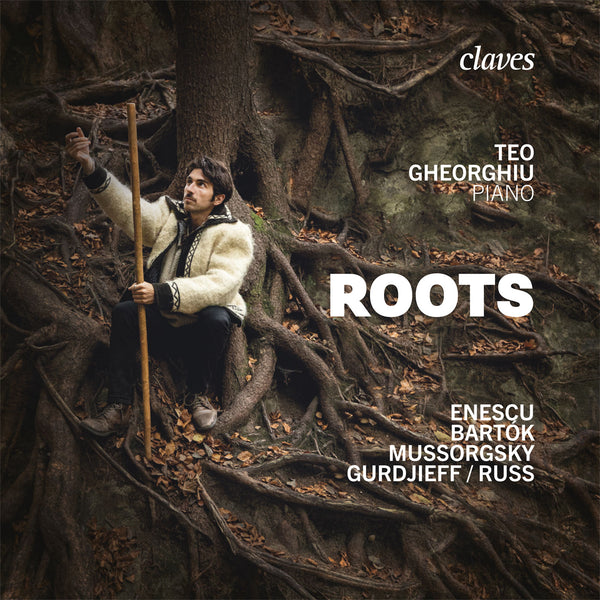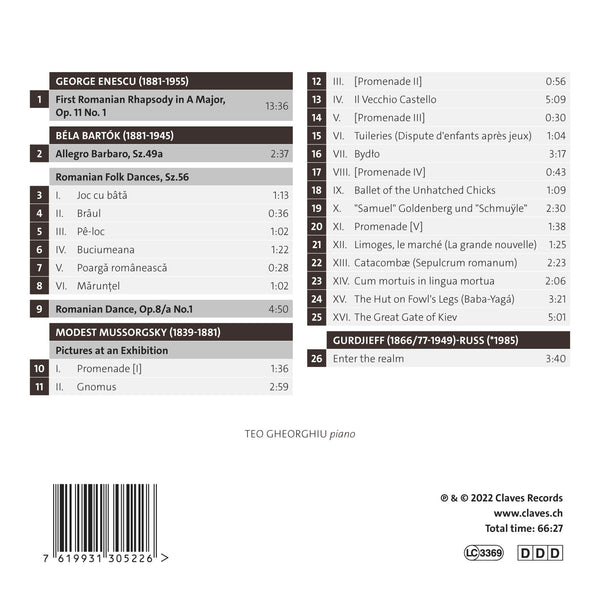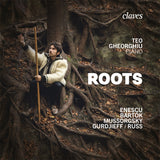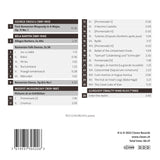(2022) Roots, Teo Gheorghiu
Category(ies): Piano
Instrument(s): Piano
Main Composer: Various composers (see collections)
CD set: 1
Catalog N°:
CD 3052
Release: 09.12.2022
EAN/UPC: 7619931305226
This album is now on repressing. Pre-order it at a special price now.
CHF 18.50
This album is no longer available on CD.
This album has not been released yet. Pre-order it from now.
CHF 18.50
This album is no longer available on CD.
CHF 18.50
VAT included for Switzerland & UE
Free shipping
This album is no longer available on CD.
VAT included for Switzerland & UE
Free shipping
This album is now on repressing. Pre-order it at a special price now.
CHF 18.50
This album is no longer available on CD.
This album has not been released yet.
Pre-order it at a special price now.
CHF 18.50
This album is no longer available on CD.
CHF 18.50
This album is no longer available on CD.
ROOTS, TEO GHEORGHIU
THE STORY
Having lived a life in the present and immediate future, the loss of my father in 2018 was a big bang that opened up a new horizon: the past.
Where have I come from?
During the communist regime under Ceausescu in the 80s, my Romanian parents left everything behind to start a new life abroad. Having been born in Switzerland and raised in London, my only connection to Romania was through music: Dinu Lipatti, Radu Lupu, Maria Tănase, Taraful Haiducilor, and many others making me vibrate with feeling.
Meanwhile, I find myself writing this in Sândominic where my grandfather grew up. This village lies in the heart of Harghita, a region in Romania populated by a proud Hungarian community going by the name of Szekely. Rolling hills recall Swiss sceneries, the summer season making a paradise bursting with colours, tastes, light, and plenty.
After spending many decades in Canada and Switzerland, my father had retraced his steps to the summers of his childhood and spent more and more time in Sândominic, where he connected with distant relatives who had welcomed him like a close friend. Ever since he had been laid to rest there next to his grandmother in late summer 2018, I have felt a deep compulsion to visit him and continue his reconnection with our roots.
This impulse led me East; crossing Germany, Austria, Hungary, and most of Romania on my road bike. Much like my dad, once I hit the road it’s all gas, no brakes, and after twelve intense days, my pilgrimage came to an end - to find a new beginning, a new understanding, and a new sense of belonging with the past nourishing the present.
Pedalling to my roots was at once cathartic and wholesome, and this album is powered by this inspiration.
Gipsy dresses swirl with extravagant flair coursing through the veins, God’s tears left in his wake
***
THE MUSIC
«The opening of this album reflects my initiation to Romania and its musical landscape. It was as a teenager that I first experienced George Enescu’s «Romanian Rhapsody No. 1», at the Enescu Festival in Bucharest no less - an unforgettable whirlwind of joyous tunes arranged in perfect chaos, bouncing off a kaleidoscope of folk colours. Discovering the solo piano version by the composer himself years later, I dived straight in and realised I was missing a third hand. Enescu had squeezed almost all the parts of a symphony orchestra into the ‘reduced’ score and the challenge was to arrange it in a way to make it humanly playable on the piano.»
«Romanian Rhapsody No. 1» (1901) was inspired by six folkloric dance tunes that George Enescu (1881-1955) grew up with, having had his first contact with music at the age of three hearing local people performing folk music. Multi-talented Enescu was to become one of the greatest violinists of all time, and even had ambitions to become a painter. Without doubt he preferred to compose, ‘for it is the endless, ever new, the future, the expectation of unknown sensations and finally the feeling that you have caught the intangible.’ It was at the young age of nineteen that Enescu finished composing what remains one of his most celebrated works.
"There is sadness even in joy. This feeling is inspired by our valleys and hills, by the special colour of our sky, by the thoughts that weigh down and at the same time give birth to a longing that cannot be well understood. Yearning seems to me the only original characteristic of Romanian songs in a music rich in Russian and Hungarian motifs.„
- George Enescu
Sharing the same birth year as Enescu, Bela Bartók (1881-1945) was born in Nagyszentmiklós, a Hungarian town that later became part of Romania and was renamed Sânnicolau Mare. He grew up to become a pianist, an influential composer, and the very first ethnomusicologist, with much of his inspiration coming from his explorations of national folk music. This included Hungarian folk but also other ethnic rhythms that he discovered while travelling through his native Transylvania and beyond. Bartók began to dispense with the rules and conventions of western classical music to be influenced by direct revelations of nature.
“My main idea, which dominates me entirely, is the brotherhood of man over and above all conflicts, this is why I am open to influence by any fresh and healthy outside sources, be they Romanian or other.„
- Bela Bartók
«Allegro Barbaro» (1911) is typical of Bartók’s style, combining Hungarian and Romanian tonalities. Allegedly written as a reaction to a Parisian critics’ jibe about Hungarian artists’ ‘barbaric’ output, Allegro Barbaro exists on the edge of freedom and wild force. For his «Romanian Folk Dances» (1917), Bartók used six original tunes which he collected from different regions of Transylvania. Originally performed on violin or shepherd flute, each tune represents a different dance form evoking scenes from joyful peasant dances and earthy celebrations to feelings of weightlessness and yearning. The driving rhythms of «Romanian Dance No. 1» (1910) date from the beginning of Bartók‘s interest in folk music, after his first trip collecting Romanian tunes in the summer of 1909.
«Having grown up going to concerts in the Tonhalle Zürich with my father, it was always a special occasion when he came to watch me play once I was giving concerts there myself. On the last such occasion, I ended the solo recital with Modest Mussorgsky’s «Pictures at an Exhibition». No other work marked my musical journey so far like this unique and unconventional universe. It proved to be the perfect platform for an enduring exploration of new perspectives, sincerity, and most of all, being fearless in extremes of expression.»
«Pictures at an Exhibition» (1874) remains Modest Mussorgsky’s (1839-1881) most important contribution to piano literature, a remarkable turnaround considering the work was never performed publicly in his lifetime. Prior to its creation, the composer had been a cosmopolitan, but was to experience a transformation, noting, ‘now I have undergone a sort of rebirth: I have been brought near to everything Russian.’ Infused by slavic folk songs, liturgical music, and fairy tales, Mussorgsky draws from the culture of his fellow countrymen, painting through sounds the realities of everyday life, death, children and animals in a dialogue that is direct and unrestricted by traditional rules and conventions.
“No one has ever appealed to the best in us in a deeper and more tender expression. Mussorgsky is unique and will remain so, for his art is free from artifice and arid formulas. Never was refined sensitivity interpreted by such simple means. It is like the art of a wild creature who discovers music in each of his emotions.„
- Claude Debussy
«To conclude the album, «Gurdjieff - ‘Enter the realm’» takes a plunge, expressing all that is outside of our grasp. In a collaboration with esteemed colleague and cherished friend, Fabian Russ, we synthesise George Gurdjieff’s philosophical teachings which strive to unite the esoteric wisdoms of the east with the scientific thinking of the west.»
Much like his contemporary, Bela Bartók, George Gurdjieff (1866-1949) travelled extensively collecting melodies and ritual dances, which his friend and pupil Thomas de Hartmann recorded and turned into piano pieces. Later in life, Gurdjieff founded an Institute for the Harmonious Development of Man. His educational work addressed all areas of human existence and included physical work, readings and ritual dances.
Teo Gheorghiu
***
TEO GHEORGHIU
Born in 1992 to Romanian parents, Swiss-Canadian pianist Teo Gheorghiu made his concert debut in his hometown at the Tonhalle in 2004. Since then, he has performed throughout the world including in Paris, Tokyo, St. Petersburg, Madrid, New York and at all of London’s major venues.
He has worked with leading orchestras including the Tonhalle Orchestra, Royal Philharmonic Orchestra, Tokyo Symphony Orchestra, Musikkollegium Winterthur and the Pittsburgh Symphony Orchestra. During his career so far he has enjoyed collaborations with esteemed conductors such as Sir Neville Marriner, John Nelson, Vasily Petrenko, Roberto Gonzalez-Monjas, Andrei Feher, Matthias Pintscher, Samy Moussa and Alexander Shelley.
Teo has won 1st prize in the San Marino and Franz Liszt International Piano Competitions. In 2010 he became the youngest recipient of the coveted Beethovenring at the Beethovenfest Bonn and was awarded the ‘Best Canadian Artist’ at the 2017 edition of Concours Musicale International de Montréal.
Teo has studied and spent most of his life in London and it is there that he spent 5 years refining his voice under the guidance of his inspirational teacher and mentor, the late Hamish Milne. Since then he has made his own way in exploring varied repertoires and new ways to reflect life into music. As well as being an avid cyclist, Teo's other passions lie in playing football, travelling, and making new discoveries in the world of folk music.
***
FABIAN RUSS
Fabian Russ is an Orchestronik practitioner. His main focus is based on working with samples and the interweaving of electronics and classical music for solo instruments up to large symphony orchestras specialised in live 3D audio listening rooms or for headphones in various format constellations. He works among others with Albrecht Mayer, Andreas Scholl, Midori Seiler and Grammy-winning 3D audio pioneer Tom Ammermann. Fabian Russ is part of a longer collaboration with Grammy winner Lasse Järvi for the development of new hybrid soundtrack formats. Using his signature style, Russ joins Järvi in providing musical accompaniment to FX’s (Disney Network) 5-part documentary ‘Dear Mama’ about rap legend Tupac, alongside Academy Award winner Atticus Ross.
REVIEWS
« Le pianiste établi à Fribourg sort un nouveau disque intitulé «Roots». Un album très intime où le musicien explore ses origines et son histoire, aussi bien sur le plan personnel que musical. Portrait. » - Valérie Passello, décembre 2022
« Teo Gheorghiu explore ses « Racines » dans un programme étonnant où Bartok et Enesco croisent les Tableaux d’une exposition de Moussorgski » - Bertrand Boissard, décembre 2022
“The pianist offers thoughtful interpretations of pieces from Romania and beyond. [..] Influenced by many but still unique, Teo Gheorghiu takes listeners on exploration of his roots in his new album” - Michael Dervan, December 2022
« Pianist Teo Gheorghiu ist in Zürich und London aufgewachsen. Das Schweizer Publikum lernte ihn als Wunderkind Vitus in Fredi M. Murers gleichnamigem Spielfilm (2005) kennen. Längst macht der heute 30-Jährige international Karriere als Konzertpianist. Sein neues Album widmet er seinem rumänischen Vater. Gheorghiu hat seine Wurzeln schon mit dem Rennrad erkundet, nun tut er es auf dem Piano. [..] » - Frank von Niederhäusern, Oktober 2022
« Le pianiste prodige et adepte du vélo sort un nouveau disque, «Roots», chez Claves. Il évoque son parcours, et la mémoire d’un pays oublié, qu’il a fini par retrouver » - Juliette de Banes Gardonne, février 2023
« [..] Sein Spiel besticht durch unfehlbare Virtuosität, aber auch durch ein ebenso grossartiges Einfühlungsvermögen in die folkloristischen Elemente dieser Tänze. Zum krönenden Abschluss dann echt Russisches: die «Bilder einer Ausstellung». Interessant, wie er die jeweiligen «Promenades» sehr persönlich gestaltet. Über weite Strecken ein in sich gekehrtes Klavierspiel, Virtuosität wird nie Selbstzweck, und die Entfesselung der Leidenschaften hält sich hier in vermutlich bewusst gesetzten Grenzen. Das alles ist rundum beeindruckend: Hier ist ein grossartig begabter Pianist am Werk. [..] » - Werner Pfister, Juli 2023
“The Swiss-Canadian pianist recital of works inspired by the folk-music of Central and Eastern Europe kicks off with Enescu's Romanian Rhapsody No. 1, which he first heard as a teenager in Bucharest and which he describes as 'an unforgettable whirlwind of joyous tunes arranged in perfect chaos'. It's followed by Bartók's Allegro barbaro and Romanian Folk Dances, Mussorgsky's Pictures at the Exhibition, and Gurdjieff's Enter the realm (arranged by Fabian Russ).” - December 2022
"Rădăcini is an expression of my Romanian blood, reflecting my story as a man and a musician," said Swiss-Canadian pianist Teo Gheorghiu, in the last interview of 2022, at Tempo Rubato, in SdC. A record revelation.” – December 2022
THE STORY
Having lived a life in the present and immediate future, the loss of my father in 2018 was a big bang that opened up a new horizon: the past.
Where have I come from?
During the communist regime under Ceausescu in the 80s, my Romanian parents left everything behind to start a new life abroad. Having been born in Switzerland and raised in London, my only connection to Romania was through music: Dinu Lipatti, Radu Lupu, Maria Tănase, Taraful Haiducilor, and many others making me vibrate with feeling.
Meanwhile, I find myself writing this in Sândominic where my grandfather grew up. This village lies in the heart of Harghita, a region in Romania populated by a proud Hungarian community going by the name of Szekely. Rolling hills recall Swiss sceneries, the summer season making a paradise bursting with colours, tastes, light, and plenty.
After spending many decades in Canada and Switzerland, my father had retraced his steps to the summers of his childhood and spent more and more time in Sândominic, where he connected with distant relatives who had welcomed him like a close friend. Ever since he had been laid to rest there next to his grandmother in late summer 2018, I have felt a deep compulsion to visit him and continue his reconnection with our roots.
This impulse led me East; crossing Germany, Austria, Hungary, and most of Romania on my road bike. Much like my dad, once I hit the road it’s all gas, no brakes, and after twelve intense days, my pilgrimage came to an end - to find a new beginning, a new understanding, and a new sense of belonging with the past nourishing the present.
Pedalling to my roots was at once cathartic and wholesome, and this album is powered by this inspiration.
Gipsy dresses swirl with extravagant flair coursing through the veins, God’s tears left in his wake
***
THE MUSIC
«The opening of this album reflects my initiation to Romania and its musical landscape. It was as a teenager that I first experienced George Enescu’s «Romanian Rhapsody No. 1», at the Enescu Festival in Bucharest no less - an unforgettable whirlwind of joyous tunes arranged in perfect chaos, bouncing off a kaleidoscope of folk colours. Discovering the solo piano version by the composer himself years later, I dived straight in and realised I was missing a third hand. Enescu had squeezed almost all the parts of a symphony orchestra into the ‘reduced’ score and the challenge was to arrange it in a way to make it humanly playable on the piano.»
«Romanian Rhapsody No. 1» (1901) was inspired by six folkloric dance tunes that George Enescu (1881-1955) grew up with, having had his first contact with music at the age of three hearing local people performing folk music. Multi-talented Enescu was to become one of the greatest violinists of all time, and even had ambitions to become a painter. Without doubt he preferred to compose, ‘for it is the endless, ever new, the future, the expectation of unknown sensations and finally the feeling that you have caught the intangible.’ It was at the young age of nineteen that Enescu finished composing what remains one of his most celebrated works.
"There is sadness even in joy. This feeling is inspired by our valleys and hills, by the special colour of our sky, by the thoughts that weigh down and at the same time give birth to a longing that cannot be well understood. Yearning seems to me the only original characteristic of Romanian songs in a music rich in Russian and Hungarian motifs.„
- George Enescu
Sharing the same birth year as Enescu, Bela Bartók (1881-1945) was born in Nagyszentmiklós, a Hungarian town that later became part of Romania and was renamed Sânnicolau Mare. He grew up to become a pianist, an influential composer, and the very first ethnomusicologist, with much of his inspiration coming from his explorations of national folk music. This included Hungarian folk but also other ethnic rhythms that he discovered while travelling through his native Transylvania and beyond. Bartók began to dispense with the rules and conventions of western classical music to be influenced by direct revelations of nature.
“My main idea, which dominates me entirely, is the brotherhood of man over and above all conflicts, this is why I am open to influence by any fresh and healthy outside sources, be they Romanian or other.„
- Bela Bartók
«Allegro Barbaro» (1911) is typical of Bartók’s style, combining Hungarian and Romanian tonalities. Allegedly written as a reaction to a Parisian critics’ jibe about Hungarian artists’ ‘barbaric’ output, Allegro Barbaro exists on the edge of freedom and wild force. For his «Romanian Folk Dances» (1917), Bartók used six original tunes which he collected from different regions of Transylvania. Originally performed on violin or shepherd flute, each tune represents a different dance form evoking scenes from joyful peasant dances and earthy celebrations to feelings of weightlessness and yearning. The driving rhythms of «Romanian Dance No. 1» (1910) date from the beginning of Bartók‘s interest in folk music, after his first trip collecting Romanian tunes in the summer of 1909.
«Having grown up going to concerts in the Tonhalle Zürich with my father, it was always a special occasion when he came to watch me play once I was giving concerts there myself. On the last such occasion, I ended the solo recital with Modest Mussorgsky’s «Pictures at an Exhibition». No other work marked my musical journey so far like this unique and unconventional universe. It proved to be the perfect platform for an enduring exploration of new perspectives, sincerity, and most of all, being fearless in extremes of expression.»
«Pictures at an Exhibition» (1874) remains Modest Mussorgsky’s (1839-1881) most important contribution to piano literature, a remarkable turnaround considering the work was never performed publicly in his lifetime. Prior to its creation, the composer had been a cosmopolitan, but was to experience a transformation, noting, ‘now I have undergone a sort of rebirth: I have been brought near to everything Russian.’ Infused by slavic folk songs, liturgical music, and fairy tales, Mussorgsky draws from the culture of his fellow countrymen, painting through sounds the realities of everyday life, death, children and animals in a dialogue that is direct and unrestricted by traditional rules and conventions.
“No one has ever appealed to the best in us in a deeper and more tender expression. Mussorgsky is unique and will remain so, for his art is free from artifice and arid formulas. Never was refined sensitivity interpreted by such simple means. It is like the art of a wild creature who discovers music in each of his emotions.„
- Claude Debussy
«To conclude the album, «Gurdjieff - ‘Enter the realm’» takes a plunge, expressing all that is outside of our grasp. In a collaboration with esteemed colleague and cherished friend, Fabian Russ, we synthesise George Gurdjieff’s philosophical teachings which strive to unite the esoteric wisdoms of the east with the scientific thinking of the west.»
Much like his contemporary, Bela Bartók, George Gurdjieff (1866-1949) travelled extensively collecting melodies and ritual dances, which his friend and pupil Thomas de Hartmann recorded and turned into piano pieces. Later in life, Gurdjieff founded an Institute for the Harmonious Development of Man. His educational work addressed all areas of human existence and included physical work, readings and ritual dances.
Teo Gheorghiu
***
TEO GHEORGHIU
Born in 1992 to Romanian parents, Swiss-Canadian pianist Teo Gheorghiu made his concert debut in his hometown at the Tonhalle in 2004. Since then, he has performed throughout the world including in Paris, Tokyo, St. Petersburg, Madrid, New York and at all of London’s major venues.
He has worked with leading orchestras including the Tonhalle Orchestra, Royal Philharmonic Orchestra, Tokyo Symphony Orchestra, Musikkollegium Winterthur and the Pittsburgh Symphony Orchestra. During his career so far he has enjoyed collaborations with esteemed conductors such as Sir Neville Marriner, John Nelson, Vasily Petrenko, Roberto Gonzalez-Monjas, Andrei Feher, Matthias Pintscher, Samy Moussa and Alexander Shelley.
Teo has won 1st prize in the San Marino and Franz Liszt International Piano Competitions. In 2010 he became the youngest recipient of the coveted Beethovenring at the Beethovenfest Bonn and was awarded the ‘Best Canadian Artist’ at the 2017 edition of Concours Musicale International de Montréal.
Teo has studied and spent most of his life in London and it is there that he spent 5 years refining his voice under the guidance of his inspirational teacher and mentor, the late Hamish Milne. Since then he has made his own way in exploring varied repertoires and new ways to reflect life into music. As well as being an avid cyclist, Teo's other passions lie in playing football, travelling, and making new discoveries in the world of folk music.
***
FABIAN RUSS
Fabian Russ is an Orchestronik practitioner. His main focus is based on working with samples and the interweaving of electronics and classical music for solo instruments up to large symphony orchestras specialised in live 3D audio listening rooms or for headphones in various format constellations. He works among others with Albrecht Mayer, Andreas Scholl, Midori Seiler and Grammy-winning 3D audio pioneer Tom Ammermann. Fabian Russ is part of a longer collaboration with Grammy winner Lasse Järvi for the development of new hybrid soundtrack formats. Using his signature style, Russ joins Järvi in providing musical accompaniment to FX’s (Disney Network) 5-part documentary ‘Dear Mama’ about rap legend Tupac, alongside Academy Award winner Atticus Ross.
REVIEWS
« Le pianiste établi à Fribourg sort un nouveau disque intitulé «Roots». Un album très intime où le musicien explore ses origines et son histoire, aussi bien sur le plan personnel que musical. Portrait. » - Valérie Passello, décembre 2022
« Teo Gheorghiu explore ses « Racines » dans un programme étonnant où Bartok et Enesco croisent les Tableaux d’une exposition de Moussorgski » - Bertrand Boissard, décembre 2022
“The pianist offers thoughtful interpretations of pieces from Romania and beyond. [..] Influenced by many but still unique, Teo Gheorghiu takes listeners on exploration of his roots in his new album” - Michael Dervan, December 2022
« Pianist Teo Gheorghiu ist in Zürich und London aufgewachsen. Das Schweizer Publikum lernte ihn als Wunderkind Vitus in Fredi M. Murers gleichnamigem Spielfilm (2005) kennen. Längst macht der heute 30-Jährige international Karriere als Konzertpianist. Sein neues Album widmet er seinem rumänischen Vater. Gheorghiu hat seine Wurzeln schon mit dem Rennrad erkundet, nun tut er es auf dem Piano. [..] » - Frank von Niederhäusern, Oktober 2022
« Le pianiste prodige et adepte du vélo sort un nouveau disque, «Roots», chez Claves. Il évoque son parcours, et la mémoire d’un pays oublié, qu’il a fini par retrouver » - Juliette de Banes Gardonne, février 2023
« [..] Sein Spiel besticht durch unfehlbare Virtuosität, aber auch durch ein ebenso grossartiges Einfühlungsvermögen in die folkloristischen Elemente dieser Tänze. Zum krönenden Abschluss dann echt Russisches: die «Bilder einer Ausstellung». Interessant, wie er die jeweiligen «Promenades» sehr persönlich gestaltet. Über weite Strecken ein in sich gekehrtes Klavierspiel, Virtuosität wird nie Selbstzweck, und die Entfesselung der Leidenschaften hält sich hier in vermutlich bewusst gesetzten Grenzen. Das alles ist rundum beeindruckend: Hier ist ein grossartig begabter Pianist am Werk. [..] » - Werner Pfister, Juli 2023
“The Swiss-Canadian pianist recital of works inspired by the folk-music of Central and Eastern Europe kicks off with Enescu's Romanian Rhapsody No. 1, which he first heard as a teenager in Bucharest and which he describes as 'an unforgettable whirlwind of joyous tunes arranged in perfect chaos'. It's followed by Bartók's Allegro barbaro and Romanian Folk Dances, Mussorgsky's Pictures at the Exhibition, and Gurdjieff's Enter the realm (arranged by Fabian Russ).” - December 2022
"Rădăcini is an expression of my Romanian blood, reflecting my story as a man and a musician," said Swiss-Canadian pianist Teo Gheorghiu, in the last interview of 2022, at Tempo Rubato, in SdC. A record revelation.” – December 2022
Return to the album | Read the booklet | Composer(s): Various composers | Main Artist: Teo Gheorghiu

















